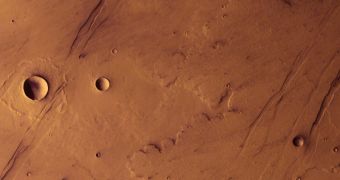Although Mars doesn't look much like a planet ravaged by volcanic activity in the past, it is clear that it had to go through such a stage in its history. Now, new observations conducted with ESA's Mars Express spacecraft reveal the actions of lava flows and water on the surface, and how these molded the Martian landscape as we see it today. The High Resolution Stereo Camera, HiRISE, on-board Mars Express, shows that Mars suffered multiple episodes of volcanic activity, which at some point in time stopped completely, instead of continuing like the geological activity on Earth.
The team investigating the images collected by HiRISE was led by Gerhard Neukum from Freie Universit?t. "We can now determine the ages of large regions and resurfacing events on the planet," said Neukum. Phenomenons such as resurfacing take place when volcanic eruptions spread lava all across the surface of the planet.
However, resurfacing processes do not seem to have had continuity throughout the history of Mars, but it most likely had occurred, in episodes of volcanic eruption. The features on the Martian surface suggest that at least five different volcanic activity episodes have taken place on Mars, during the period of time when the planet was much warmer and wetter than it currently is, about 3.8 thousand million years ago.
After each episode, the Red Planet would have gone through a relatively calm geological period. Pictures of the Martian surface suggest that the five episodes occurred successively, with the first beginning around 3.5 thousand million years ago, the second 1.5 thousand million year ago, then 400-800 million years ago, 200 million years ago and the last 100 million years ago, with a margin of error of 100-200 million years for the earlier episodes, while the latter are estimated within an error of 20-30 million years.
Neukum reveals that the ages have been estimated by counting the small craters on the surface, as older surfaces would present larger number of craters of all sizes. Nevertheless, critics argue that the method implied by Neukum may not be as accurate as thought, in fact most of the craters may not even be created by falling pieces of space rock, but by fragments thrown out by large impacts with small asteroids and meteorites. On the other hand, Mars Orbiter Camera researchers clearly show that new craters have appeared on the Marian surface during the seven years in orbit around the planet.
"The present day cratering rate can be calculated from their observations," says Neukum. It is possible that during the eruption, the heat generated by molten lava released water vapor into the atmosphere, thus determining large scale floods on the surface. It looks like the volcanic activity on Mars is now frozen, but it might all be an illusion. It is clear that the planet has been trying to establish plate tectonics, and there is a good probability that the core is not yet too cold to determine new eruptions in the future.

 14 DAY TRIAL //
14 DAY TRIAL //